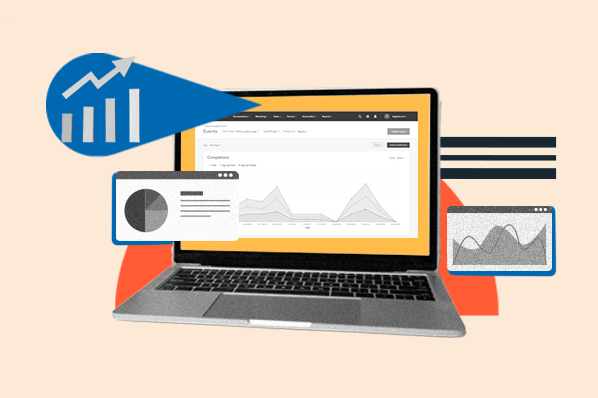Can your brand get sick? Not really — but brand health can suffer from bad customer reviews, negative PR, and more.

According to a report by Edelman, 81% of consumers need to be able to trust a brand before buying from it.
Consistently tracking and analyzing your brand health can help you generate and maintain trust with your audience, including existing and new customers.
This article explains in detail what brand health is, how to track it, and how to safeguard it. Let's break it down.
Free Kit: How to Build a Brand [Download Now]
What is brand health?
Brand health is a collection of metrics around your brand used to represent the customers’ perception of your brand, products and services, public image, and communication. Simply, it helps to examine if people are happy with your brand, what aspects of it they highlight, and in what way.
It’s important to note that brand health goes beyond customer satisfaction with your products and services and encompasses your overall branding.
Brand health metrics provide an insight into the efficiency of your brand and answer questions like:
- How does your brand affect your business?
- How reliable is it?
- How does your brand connect with your customers?
- How strong is it against your competitors?
You can better understand whether your brand is thriving or ailing by getting these answers. Your task as a marketer, online reputation manager, or PR specialist is to detect and solve issues before they’re fatal.
Measuring Brand Health
Customer feedback, social listening, and focus groups and surveys are three common ways to measure brand health.
Customer Feedback
Customers play a major role in your brand's health because they can either leave positive reviews online or negative. They can also recommend your product or service to friends or encourage their friends to go elsewhere.
To assess customer feedback, conduct interviews that give insight into what customers like or dislike about your brand, why they prefer it over competitors, and how their feelings toward it have changed over time.
Regularly use simple feedback forms and in-depth interviews to get the most up-to-date customer data.
Pro-Tip: To collect customer satisfaction feedback, ask consumers questions like "How did you use …?" or "How did you feel about …?" These questions can be asked via comment boxes, pop-up forms, and post-purchase forms.
Social Listening
With social listening, you can get insight into brand voice, brand reputation, and brand awareness; however, this method doesn't work if your audience isn't active on social media.
Social listening means using social media monitoring tools to track mentions of your brand, relevant hashtags, or keywords associated with your brand on the web, in forums, or on various social media platforms.
After gathering the needed information, you can assess your audience's sentiments toward your brand.
Pro Tip: HubSpot's Social Media Management Software is one of many tools you can use to manage and track your social media.
Focus Groups and Surveys
If you're looking for answers to specific questions regarding your brand's health — focus groups and surveys are what you need. By leveraging surveys and focus groups, you can gain a much more comprehensive look into how people perceive your brand.
Pro Tip: We've created an ultimate guide to help you craft and distribute the right surveys to assess your brand's reputation.
Why is measuring brand health important?
The better people feel about your brand, the more customers become brand advocates and devoted followers on your social networks.
They want as many people as possible to know about your products and services and help boost your brand awareness.
On the flip side, dissatisfied consumers publish angry reviews on Yelp, dislike your posts on Facebook, and mention your brand in hot discussions on Reddit. This also boosts your brand awareness — and the notoriety of your company.
That’s why you must detect any spikes in your brand mentions online. It helps prevent reputation crises and provides feedback on improving your products, services, and overall brand.
Brand Health Metrics
- NET Promoter Score (NPS)
- Share of Voice (SOV)
- Brand Reputation
- Purchase Intent
- Brand Equity
- Traffic-Driving Brand Keywords
There is no one formula to check your brand health quickly and easily. Instead, it’s like an air traffic controller looking at a dashboard with dozens of indicators. You must track them all at once to detect any problems.
Below let’s look at what indicators you need on your dashboard.
1. NET Promoter Score (NPS)
NPS shows whether your brand is “healthy” by comparing the number of positive and negative online mentions dedicated to your company. Here is a formula:
Net Promoter Score = % of positive mentions - % of negative mentions
For instance, you want to determine your NPS on Yelp. First, you need to know how many positive and negative reviews your brand earned in absolute and percentages. Then, subtract positive from negative to get your NPS.
The higher number you have, the better your online sentiment is. It means people would instead like your company than dislike it.
If you get a negative number, take steps to save your reputation! Primarily you can start searching for all negative comments and reviews on the web and replying to them.
Manual measuring NPS is a tedious task. You need to read and analyze all comments and reviews where your brand is mentioned on forums, social networks, and review sites. Sometimes, your customers’ attitude is not the scores you earned.

2. Share of Voice (SOV)
You don’t understand how much of the market your brand takes up without benchmarking your metrics to your competitors. That’s why you must also track the competition and analyze their results.
SOV is the percentage of your brand mentions over the Internet compared to other companies in the industry. This metric points to your brand awareness and reveals how many people know about your products or services.
For instance, if the food companies Oatly and Alpro have 26.8% and 73.2% of mentions on the web, respectively — the SOV of Alpro is bigger.
However, it doesn’t mean that plant milk lovers prefer Alpro over Oatly products. That would indicate that more people recognize this brand and write something about it online.

3. Brand Reputation
Measuring this metric by numbers is hard since brand reputation contains many aspects of your company’s image. Measuring brand reputation means analyzing different metrics that give you an idea of how customers perceive your brand.
Pay attention to the volume of your mentions online. How many people know about your company? Have you any mentions in influential blogs, news sites, and social communities? Where in the world is your product or service known better?
SOV and NPS (or online sentiment) are important indicators, too.
Tracking PR campaigns helps you measure how often content about your brand is being shared or written about in media outlets.
Finally, you can count how many followers on social pages and visitors to your website you have.
Regularly monitoring your success with emails, PPC, newsletters, YouTube clips, and landing pages is a reliable way to determine your brand reputation.
Ultimately, brands from customers’ bad books can hardly earn many views and like on video platforms.

4. Purchase Intent
It is another complicated metric in the list. Simply put, purchase intent is a customer’s readiness to buy from you.
Usually, selling your products or services, you deal with four different groups of customers. They are at various stages of a customer journey. Take a look at the table to understand what I mean.
|
Stage |
What are customers doing? |
Purchase intent status |
|
Awareness |
Search for products or services they need on the web, read blog posts, how-to articles, watch interviews with experts and infomercials. |
Informational — “What options do I have?” |
|
Consideration |
Having a couple of brands as options, customers look for reviews dedicated to them, read comparison pages, download white papers from your webpage or even sign up for a trial. |
Navigational — “What is an optimal option for me?” |
|
Purchase |
Add items to cart, book demos, check pricing pages. |
Transactional — “How much does the best option cost?” |
You can ask: where is the fourth group? The point is all customers described above are active. However, some passive ones have not yet started their journey as your potential buyers.
This is a group with passive purchase intent. For now, these customers will not buy your product because they don't need it. But they might do it in the future.
Of course, the fewer prospects in your passive group, the better your brand health is. To check this indicator, pay attention to how many people don’t buy from you after they use the trial.
You should also assess the number of clients with expiring contracts you have and your customer’s churn rate.
On the flip side, unsatisfied’ competitors’ customers are also buyers with passive purchase intent. However, this is another marketing story.
5. Brand Equity
This complex metric shows the value of your brand. Financially, this is the value you gain from your brand name recognition compared to a generic equivalent (Investopedia).
Simply saying, it reveals how much more you earn thanks to the brand. Selling just sneakers, not Nike, laptops, or Apple, will hardly bring you a million-dollar profit.
Brand equity is a blend of several ingredients, such as consumer perception, familiarity, quality, consideration, and value.
On the web, you can find a lot of lists with the most valuable brands or the brands of the year that consulting, trend-watching, and research firms provide.
Measuring brand equity is a fascinating task indeed. Primarily, it is because of a plethora of approaches you can use.
For example, you can calculate the total amount of money you spent on building a brand from the start till date (a historical method).
Also, you can take the price difference between a branded product and a generic one and then multiply it by the total branded sales volume (price premium method).
Additionally, all the metrics described earlier give you an idea of your brand equity.
When your company’s online sentiment is OK, your share of voice is more significant than your competitors, and you have enough customers, your brand performs well.
6. Traffic-Driving Brand Keywords
"I would primarily focus on the amount of brand keywords driving organic traffic to my site and see if my brand alone is able to generate organic traffic based on specific actions," said HubSpot's Senior Technical SEO Specialist Sylvain Charbit.
Charbit uses a shoe store as an example.
"Let’s say I own a shoe store called 'Runnyran' and organize event X. Will I see a surge/steady traffic coming from keywords like 'Runnyran event X'? These are indicators of a healthy brand for SEO," he said.
Brand Health Tools
Unfortunately, no single tool lets you measure brand health with the click of a button. However, plenty of tools can automatically gather and display the multiple metrics related to brand health.
Take a look at some of your best options below. By the way, you can sign up for a free trial for any of them!
1. Awario

Awario is a social listening and media monitoring tool that provides all the data you need to check your brand health.
Awario scans social platforms (e.g., Twitter, YouTube, Reddit), blogs, news sites, and other online sources, turning this information into easy-to-read analytics.
Simply type in your brand name, and choose your language, location, and date range. Additionally, you can use industry-related keywords or your CEO’s name to expand your search.
There is also a Boolean mode for advanced search fans. Then, wait for a couple of minutes and enjoy the stats.
For instance, you can check Topic cloud to understand what keywords and hashtags your brand is associated with. The Sentiment graph indicates whether your customer perception of your company is good.
You can also dive into all brand mentions to reveal where on the web people are talking about you, who they are, and what they are discussing.
Finally, go to the Alert comparison tab to benchmark your results against your competitors (including Share of voice).
Pricing: $24/mo for the Starter plan, $74/mo for Pro, and $249/mo for Enterprise. You can save up to 40% with a yearly plan.
2. Meltwater
 Meltwater is a robust brand health tool that leverages media monitoring and social listening to provide comprehensive insights into brand performance. It keeps track of how people talk about brands on news, blogs, and social media. This helps businesses understand what people think and find new trends. Meltwater's analytics help brands understand their market position, measure the impact of their PR efforts, and benchmark against competitors. With its advanced AI capabilities, Meltwater is capable of delivering comprehensive reports and real-time alerts, enabling brands to make data-driven decisions and uphold a robust, positive brand image.
Meltwater is a robust brand health tool that leverages media monitoring and social listening to provide comprehensive insights into brand performance. It keeps track of how people talk about brands on news, blogs, and social media. This helps businesses understand what people think and find new trends. Meltwater's analytics help brands understand their market position, measure the impact of their PR efforts, and benchmark against competitors. With its advanced AI capabilities, Meltwater is capable of delivering comprehensive reports and real-time alerts, enabling brands to make data-driven decisions and uphold a robust, positive brand image.
Pricing: Contact for custom pricing.
3. Brand24

Brand24 provides similar features to Awario. This tool gathers various analytics around brand health by analyzing your mentions — an industry-related keyword or brand name — on Twitter, Instagram, Facebook, podcast, news sites, and forums.
To navigate the data, you can use filters such as sentiment, influencer score, the mention importance based on the source's popularity, and the post's engagement rate.
Also, Brand24 estimates your brand reach on social and non-social platforms and calculates the number of user-generated posts, videos, and likes.
Additionally, the tool indicates how much money you would have to spend on ads promoting your company.
The comparison feature enables you to analyze your competition. You can see what company earned more online mentions (including negative and positive ones) on various online platforms.
Pricing: Individual is $69/mo, Team is $129/mo, Pro is $179/mo, and Enterprise is $349/mo. You can get two months free with a yearly plan.
4. Mentionlytics

Mentionlytics provides informative charts around your brand mentions everywhere on the Internet.
Mentionlytics searches for your brand name or keywords on Instagram, Facebook, LinkedIn, Reddit, and YouTube and shows the results on a dashboard with graphs and pie diagrams dedicated to different sources.
You can use filters to see all Twitter replies or YouTube comments only. Also, you can sort the data by source, country, sentiment, relevance (normal or strict), and language. The Share of voice metric is available as well.
The Mentionlytics reporting feature helps you get marketing insights about your brand.
For example, the tool detects significant articles and posts regarding reach, engagement, and sentiment, social profiles with suspicious behavior, and popular hashtags.
Pricing: $49/mo for the Basic plan, $99/mo for Essential, $199/mo for Advanced, and $299/mo for Pro. You can save two months with a yearly plan.
5. Google Trends

Google Trends is a website by Google that analyzes the popularity of top Google searches across different regions and languages. It also allows users to compare the relative search volume of searches between multiple terms.
"Google Trends is most helpful when compared with your brand competitors as a benchmark, in a week or 30-day intervals," said Victor Pan, growth expert from HubSpot's Marketing Growth team.
Pan says Google Trends was instrumental when he worked as the SEO agency of record for Crest toothpaste.
At the time, the Colgate brand mentions were skyrocketing after the FDA banned an ingredient found in Colgate called triclosan.
"Aside from 'Colgate triclosan' queries, we started seeing 'crest triclosan' queries show up in Google Trends and Google Autosuggestions as people were completing their queries for 'crest' in the Google search bar," Pan recalled.
He said, "We turned Colgate's crisis into Crest's opportunity, launched a triclosan-free toothpaste page, and ran paid ads on triclosan toothpaste searches to inform consumers how they could switch to Crest if Colgate's ingredients are suspect."
Pricing: Free
Keeping Your Brand Healthy
Regularly checking your brand health indicators works like health screening: it helps you detect the first signs of dangerous diseases and heal chronic illnesses. These preventative measures are always cheaper and more effective.
If you start today, you can ensure your brand is OK and robust, and prosperous in the future.




![10 Best Tools to Check Website Traffic [+ What They’re Best For]](https://www.hubspot.com/hubfs/GettyImages-1332148900%20copy.jpg)
![Why You Should Want Visitors to Click Through Multiple Screens [Data + Tips]](https://www.hubspot.com/hubfs/GettyImages-1256724253.jpg)



